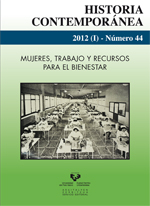Survival strategies of poor women in Guipuzcoa. The cases of San Sebastián and Tolosa (1885-1915)
##plugins.themes.bootstrap3.article.main##
##plugins.themes.bootstrap3.article.sidebar##
Abstract
In 1855, the first Spanish Public Welfare Act, ordered municipalities with more of 5.000 inhabitants to provide to the poor families, medicines and doctor's assistance free. All the people who wants to access was included in a Poor's Register. The presence of women in the Poor's Register is proportionally very high. There survival strategies were formed directly in connection with the labour markets. Comparating poor women of two localities whose labour markets were very different, we can to prove how, in San Sebastian, town of services and with a little offer of work in other fields, women resorts to different uses of home that was very expensive and scant.
In the other locality analyzed, Tolosa, an industrialized village, poor women and their families when they do not earn enough money to survive at the factories where they works or they were unemployed, they lived on alms or they enter in the poor's institution. The two issues appears very natural for the working families and no like a social break.
##plugins.themes.bootstrap3.article.details##
women, poverty, gender, survival, poor registers
Authors publishing in the journal Historia Contemporánea agree to the following terms:
- Authors retain full copyright of their papers, but also grant copyright to the academic publisher (UPV/EHU Press) for the purposes of copyright management, vigilance and protection.
- Papers are by default published with a non-restrictive Creative Commons CC-BY-NC-ND 4.0. You are free to: Share, copy and redistribute the material in any medium or format. The licensor cannot revoke these freedoms as long as you follow the license terms. Under the following terms:
Attribution — You must give appropriate credit, provide a link to the license, and indicate if changes were made. You may do so in any reasonable manner, but not in any way that suggests the licensor endorses you or your use.
NonCommercial — You may not use the material for commercial purposes.
NoDerivatives — If you remix, transform, or build upon the material, you may not distribute the modified material.
No additional restrictions — You may not apply legal terms or technological measures that legally restrict others from doing anything the license permits.
- If an author requires a more restricted CC license (e.g. CC-BY-SA), this can be provided by contacting our publisher at: publications@ehu.eus
- In particular, and without having to request additional permission, CC BY-NC-ND licensed papers can be deposited in institutional repositories and academic web sites.
- Postprints (i.e. accepted but non-edited versions of the manuscript) can also be pre-published online, providing acknowledgement of authorship and source is specified as above.
For non-standard uses of papers or materials published in Historia Contemporánea, please contact our publisher UPV/EHU Press at: publications@ehu.eus

